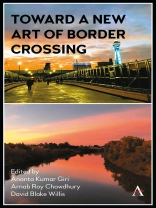Boundaries, borders and margins are related concepts and realities, and each of these can be conceptualized and organized in closed or open ways—with degrees of closure or openness. The logics of statis and closure, as well as cults of exclusivist and exclusionary sovereignty, are reflected and embodied in the closed xenophobic conceptualization and organization of boundaries, borders and margins. But, an open conceptualization of the borderlands, where mixing and hybridity take place at a rapid, even dizzying, pace, gives rise to Creolization—at the threshold of sovereignties, as something that can also be imagined.
At present, our border zones are spaces of anxiety-ridden security arrangements, violence and death. The existing politics of boundary maintenance is wedded to a cult of sovereignty at various levels, which produces bare lives, bodies and lands. We need the new art of border-crossing to bedefined by the notion of camaraderie and shared sovereignties and non-sovereignties. Border zones can also be zones of meetings, communication, transcendence and festive celebration of the limits of our identities. Thus, we need a new art and politics of boundary transmutation, transformation and transcendence, in the broadest possible sense, that entails the production of spatial, scalar, somatic, cognitive, affective and spiritual transitions.
Crossing Borders is a powerful theme and metaphor for all of us in the midst of COVID-19 (since 2020) and the current geopolitics of war that is hovering over Eurasia. We need these modes of knowing and being that shun violence; ontologies that are fluid and seeking instead of aggressive, self-certain, arrogant and violent. Amidst this chaos, we need new modes of knowing, or epistemologies, where knowing of, or about, the other is also a festive and artistic process of knowing with the other. We need an artistic ontological-epistemology of participation for a new art of border-crossing where the boundary between ontology and epistemology is continually redrawn with emergent negotiation and creativity.
Зміст
Preface; Notes on Editors and Contributors; Toward a New Art of Border Crossing: An Introduction and an Invitation, Ananta Kumar Giri, Arnab Roy Chowdhury, and David Blake Willis; Part One Toward A New Art of Border Crossing: Reflective Horizons, Chapter 1-Toward a New Art of Border Crossing, Ananta Kumar Giri; Chapter 2-The New Art of Crossing Borders: Pandemic Disease, Climate Crises, and Epidemic Racism as Planetary Challenges, David Blake Willis; Chapter 3-Fluid Identity and Overcoming Boundaries, Soraj Hongladarom; Chapter 4-Conjuring at the Margins: A Transcontinental Approach to Interpreting Border Art, Julie Geredien; Chapter 5-New Arts of Border Crossing: Tagore’s Engagement with Borders, Meera Chakravorty;
Chapter 6-Garrison—Thoreau—Gandhi: Transcending Borders, Christian Bartolf, Dominique Miething, and Vishnu Varatharajan; Chapter 7-Comparare Philosophy Within and Without Borders Agnieszka Rostalska and Purushottama Bilimoria; Chapter 8-From Hegemony to Counter Hegemony: Border Crossing in Philosophical Discourse, Saji Varghese; Part Two Toward a New Art of Border Crossing: Movements in Societies and Histories, Chapter 9-Between the Left, the Liberal, and the Right: Post-colonialism, Subaltern Studies, and Political ‘Border Crossing’ in India, Arnab Roy Chowdhury; Chapter 10-Directions: Exit, Voice, and Loyalty and the Modern History of Migration, Ronald Stade; Chapter 11-Crossing the German–German Border from the End of World War II until 1990: From Escape to Alienation, Detlef Griesen; Chapter 12-Overcoming the Borders in Southeast Asia? An Analysis of Transborder Collaboration in the Greater Mekong Subregion, Detlef Griesen; Chapter 13-Post Oil Migration Futures in the Khaleej: Thinking With/Out Borders, Manishankar Prasad; Chapter 14- Transnational Communities and the Formation of Alternative Sociopolitical Otherness, Abdulkadir Osman Farah;Part Three Toward a New Art of Border Crossing: Religion, Politics, Art and Transcendence, Chapter 15-Crossing Borders and Creolization: Creating and Negotiating New Worlds, David Blake Willis; Chapter 16-Visual Construction of Borderlands: The Case of Tohono O’odham Nation at US–Mexico Borderlands [within US and Mexico] and Their Subaltern Narrative, Ahmed Abidur Razzaque Khan and Abdur Razzaque Khan; Chapter 17-High Tech for the External Border, Ralf Homann and Manuela Unverdorben; Chapter 18-Journeys and Myths: Transcending Boundaries in Amitav Ghosh’s Gun Island, Amrita Satapathy and Panchali Bhattacharya; Chapter 19-Transgressing Borders and Boundaries: Religion, Politics, and Art from the Pharaoh Khafra to the Work of Siona Benjamin, Ori Z. Soltes; Chapter 20-Transgression, Transcendence, and Meaning Creation in Art: Mystico-Artistic Route for Re-enchanting the World, Muhammad Maroof Shah; Index
Про автора
Ananta Kumar Giri is a professor (sociology and anthropology) at the Madras Institute of Development Studies (MIDS) in Chennai, Tamil Nadu, India.
Arnab Roy Chowdhury is an assistant professor (sociology) at the Higher School of Economics Moscow (HSE) University, Moscow, Russian Federation.
David Blake Willis is a professor of anthropology and education at Fielding Graduate University, Santa Barbara, California, USA.












